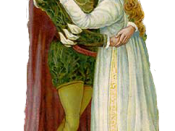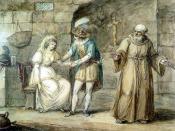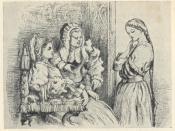Baz Luhrmann's Romeo + Juliet is a fast paced adaptation of the 1595 Shakespeare play of Romeo and Juliet; but for the MTV-generation. Luhrmann portraits the classic tale of the two star-crossed lovers in a way in which an audience today can understand and relate to the events in the drama without being tied down long drawn out speeches and uncommon dress. But when boiling it all down, the similarities between Shakespeare's and Luhrmann's "Romeo and Juliet" outweigh the differences between the two.
As the viewer enters Verona Beach they are reminded of a Miami or Los Angeles type area after a gang war. With fast-paced cut scenes on top of a newscast the viewer sees the two reigning sky scrapers that are the marks of the Montague and Capulet families. Everywhere looks similar to a third-world country until the viewer is introduced to the Montague family in a limo and taken into the house of Capulet at their extravagant ball.
This is much easier for modern viewers to relate to in the sense that they can picture a world like this where the rich control most everything, compared to a 16th century Verona, Italy in which things are, more often than not, foreign to audiences today and has a hard time holding the attention of audiences. The opening scene sets the stage for violence and feuding within families. As the Montagues and Capulets arrive at the same gas station, a quarrel is started. The audience clearly sees the gang-like separation of the houses and can immediately understand why a fight would go down here; because that same thing happens today at the same places.
The characters in Lurhmann's are brilliantly designed to adapt to the culture today but still convey the same message as Shakespeare's characters. In the film...


